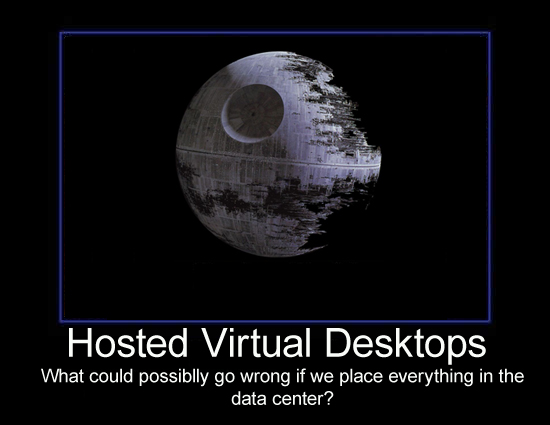Recently I wrote a guest editorial for Virtual Strategy Magazine, although I have to admit I wasn’t made aware of my goofy picture – look away I’m hideous – until the article was published. You can find the full contents at Virtual Strategy Magazine
citrix
Client Hosted Virtual Desktops Part II; Back to Basics
CSO Online Podcast
Client Hosted Virtual Desktops Part 1; Own the OS
We all know that IT security and operations is becoming a more challenging and untenable problem day by day – see “Top 10 Reasons Your Security Program Sucks and Why You Can’t Do Anything About it” – The reality is that we continue to build on top of inherently insecure and fundamentally weak foundations, such as the operating systems and routing infrastructures that power much of the global economy.
We need an alternative to the current computing paradigms that all organizations struggle with.
Client-Side Virtualization Part III: HAL 9000, Hosted Virtual Desktops, and the Death Star
Systems and security management is difficult, ineffective, costly and becoming ever more so in increasingly distributed, heterogeneous, complex, and mobile computing environments…
- 98% of all external attacks take advantage of poorly administered, misconfigured, and unmanaged systems (Source: Verizon Data Breach Investigations Report 2009)
- A locked down and well managed PC can cost 42% less than an unmanaged one (Source: Gartner – The Total Cost of Ownership: 2008 Update)
- The direct costs incurred in a “somewhat managed” PC are only slightly lower than the direct costs of an unmanaged PC, because of expenses to maintain underutilized or dysfunctional management systems (Source: Gartner – The Total Cost of Ownership: 2008 Update)
The benefits provided by server virtualization are being realized as server consolidation has enabled cost reduction and efficiencies in data center/server management. This is of course leading many to ask the question “why can we not virtualize our desktops as well?” Continue reading
Client-Side Virtualization Episode II: Standardization, Attack of the Clones and Desktops Reloaded
Consolidation is the major benefit or “killer app” for server/data center virtualization. Standardization is the major benefit or “killer app” for client-side virtualization.
As I was pondering the challenges of current systems management processes, researching the latest and greatest from the client-side virtualization vendors, and talking to a lot of large organizations I was trying to find that one thing that explained the operational benefits of client-side virtualization. There are more than one, but it really does come down to standardization, allow me to explain… Continue reading
Desktop Virtualization Overview; The Good, The Bad, and The Reality – VDI is DOA!
To address the increasing cost and complexity of managing dynamic IT environments organizations are trying to understand how to adopt virtualization technologies. The value proposition and “killer app” are quite clear in the data center, however less attention has been given to the opportunities for endpoint virtualization. Even though there are multiple methods to address client-side virtualization; hosted virtual desktops (HVD), bare-metal hypervisors, local and streaming virtual workspaces and a range of options that layer on top of and between them all, such as application virtualization, portable personalities, and virtual composite desktops, there is still a tremendous amount of confusion and even more misconceptions about the benefits of client-side virtualization than with server virtualization. The major architectural flaw in almost all of these solutions is they remain very back end and infrastructural heavy, which reduces the benefit of cost-reduction and lower complexity.
Unlike server virtualization, which drove adoption from the bottom up, that is from the hypervisor and then through the other stacks, adoption of endpoint virtualization technologies is moving top down, that is starting with single applications within an existing OS. Application virtualization adoption will accelerate over the next 12-18 months with Gartner life cycle management analyst suggesting that it will be included in the majority of PC life cycle RFP’s in 2010 and beyond. Workspace/Desktop virtualization will follow over the next 24-36 months, as will the endpoint virtualization infrastructures. The adoption of both workspace/desktop and endpoint virtualization infrastructure will align with organizations desktop refresh cycles. Considering the average is between 3-5 years and considering that many are looking at desktop refresh to support Vista, although it probably only has about a 10% market adoption, and Windows 7, it is conceivable that we will begin seeing accelerated adoption of desktop and infrastructure virtualization over the next 24-36 months as organizations rethink their current systems management processes and technologies.
Let’s look at the 4 client/desktop virtualization models I believe will become the most prevalent over the next 3-5 years… Continue reading





